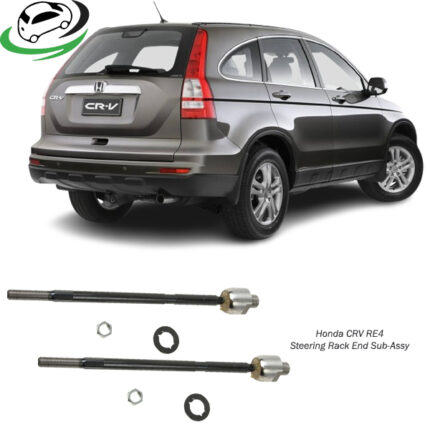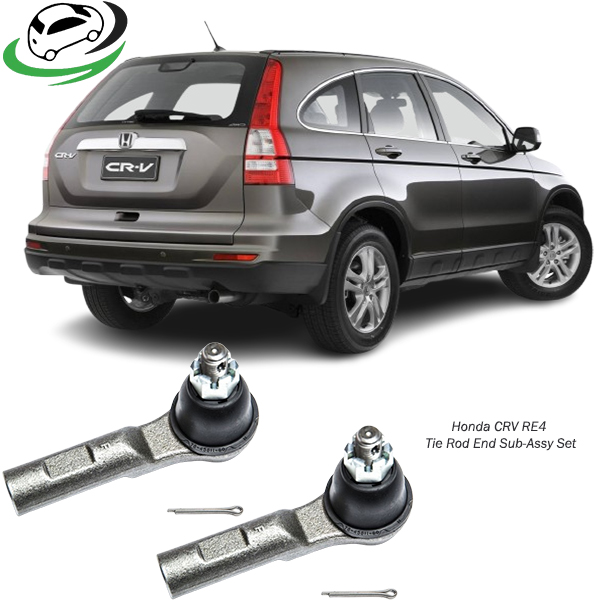-10%
Get Honda CRV RE4 Tie Rod End Sub-Assy Set SEH021 in Kenya
The tie rod end sub-assembly set is a critical component of a vehicle’s steering system, playing a vital role in maintaining proper handling and stability while driving. As a part of the steering linkage, tie rod ends connect the steering gear to the steering knuckle, allowing the driver to control the direction of the vehicle. This detailed overview will explore the functions, components, maintenance, and importance of tie rod end sub-assembly sets in automotive applications.
1. Understanding Tie Rod Ends
a) Definition and Function
A tie rod end is a spherical bearing that connects the tie rod to the steering knuckle or wheel assembly. Its primary function is to transmit the steering motion from the steering gear to the wheels, allowing for directional changes. The tie rod end also accommodates the vertical movement of the suspension while maintaining a connection with the wheels.
b) Importance in the Steering System
Tie rod ends are essential for ensuring accurate steering and vehicle control. They help maintain proper alignment and stability, providing feedback to the driver about the vehicle’s handling. Worn or damaged tie rod ends can lead to steering issues, affecting the overall safety and performance of the vehicle.
2. Components of Tie Rod End Sub-Assembly Set
A typical tie rod end sub-assembly set consists of several components that work together to provide efficient steering. These components include:
a) Tie Rod Ends
- Inner Tie Rod End: Connects to the steering rack and allows for linear motion.
- Outer Tie Rod End: Connects to the steering knuckle and accommodates steering angles.
b) Boots
Boots are protective covers that encase the tie rod ends, preventing dirt, debris, and moisture from entering the joints. They help prolong the life of the tie rod ends by keeping them lubricated and preventing contamination.
c) Locknuts and Castle Nuts
These fasteners secure the tie rod ends to the steering knuckle and inner tie rod. Castle nuts feature notches for a cotter pin to prevent loosening, while locknuts provide additional security.
d) Cotter Pins
Cotter pins are used to secure the castle nuts in place. They prevent the nut from loosening over time, ensuring the tie rod ends remain securely attached.
e) Grease Fittings
Some tie rod end assemblies include grease fittings for easy lubrication. This feature allows for routine maintenance to ensure smooth operation and longevity.
3. Types of Tie Rod Ends
There are several types of tie rod ends, each designed for specific applications. The most common types include:
a) Standard Tie Rod Ends
These are the most commonly used tie rod ends, featuring a simple ball joint design that allows for smooth movement while providing adequate support for steering.
b) Adjustable Tie Rod Ends
Adjustable tie rod ends allow for changes in length, which can help with vehicle alignment adjustments. These are especially useful in racing applications or vehicles with modified suspensions.
c) Heavy-Duty Tie Rod Ends
Heavy-duty tie rod ends are designed for trucks, SUVs, and performance vehicles that experience higher loads and stresses. They are typically constructed with stronger materials and thicker designs.
4. Signs of Worn Tie Rod Ends
Over time, tie rod ends can wear out due to constant movement and exposure to road conditions. Here are some common signs indicating a need for replacement:
a) Uneven Tire Wear
Worn tie rod ends can lead to improper wheel alignment, resulting in uneven tire wear. Drivers may notice that tires wear out faster on one side than the other.
b) Steering Play
Excessive play in the steering wheel is a key indicator of worn tie rod ends. If the driver feels a looseness or excessive movement when turning the wheel, it may signal that the tie rod ends need inspection.
c) Vibration or Noise
Drivers may hear clunking, popping, or rattling noises when driving over bumps or turning corners, indicating that the tie rod ends are failing. Vibrations in the steering wheel can also occur if the tie rod ends are worn.
d) Misalignment
If the vehicle pulls to one side or the steering wheel is off-center while driving straight, it may indicate a problem with the tie rod ends or other suspension components.
5. Importance of Tie Rod End Maintenance
Regular maintenance of tie rod ends is crucial for ensuring the longevity and performance of the steering system. Here are some maintenance tips:
a) Routine Inspections
Regular inspections of the tie rod ends should be part of routine vehicle maintenance. Look for signs of wear, such as cracks in the boots, looseness in the ball joint, and any abnormal noises.
b) Lubrication
If equipped with grease fittings, tie rod ends should be lubricated periodically to reduce friction and wear. Following the manufacturer’s recommendations for lubrication intervals is essential.
c) Alignment Checks
Vehicle alignment should be checked regularly, especially after tire rotations or suspension repairs. Proper alignment ensures even tire wear and helps maintain control over the vehicle.
d) Replacement
If any signs of wear or damage are present, timely replacement of the tie rod ends is essential. Delaying replacement can lead to more severe issues, including suspension damage and increased repair costs.
6. Installation of Tie Rod End Sub-Assembly Set
Proper installation of the tie rod end sub-assembly set is crucial for ensuring optimal performance. Here’s a general guide to installation:
a) Tools Required
- Wrenches and socket sets
- Torque wrench
- Pliers
- Grease gun (if applicable)
- Ball joint separator (if necessary)
b) Steps for Installation
- Lift the Vehicle: Use a jack to lift the vehicle and secure it with jack stands. Ensure the vehicle is stable before working underneath.
- Remove the Old Tie Rod Ends: Use wrenches to loosen and remove the locknuts and castle nuts from the existing tie rod ends. A ball joint separator may be needed to disconnect the tie rod ends from the steering knuckle.
- Install New Tie Rod Ends: Position the new tie rod ends into the steering knuckle and tighten the castle nuts and locknuts according to the manufacturer’s torque specifications.
- Reconnect Inner Tie Rod: Attach the inner tie rod end to the steering rack. Ensure proper alignment with the steering assembly.
- Grease the Tie Rod Ends: If applicable, use a grease gun to apply grease to the tie rod ends, ensuring adequate lubrication.
- Check Alignment: After installation, it’s essential to have a professional alignment performed to ensure proper vehicle handling and tire wear.
7. Conclusion
The tie rod end sub-assembly set is an essential component of a vehicle’s steering system, providing crucial support for steering control and vehicle stability. Understanding the function, types, and maintenance of tie rod ends can help vehicle owners ensure a safe and comfortable driving experience. Regular inspections and timely replacements are key to preventing steering issues and maintaining overall vehicle performance. By prioritizing the health of tie rod ends, drivers can enhance their vehicle’s handling, prolong component life, and ensure safety on the road.
Follow us on Facebook for more parts.




Reviews
Clear filtersThere are no reviews yet.